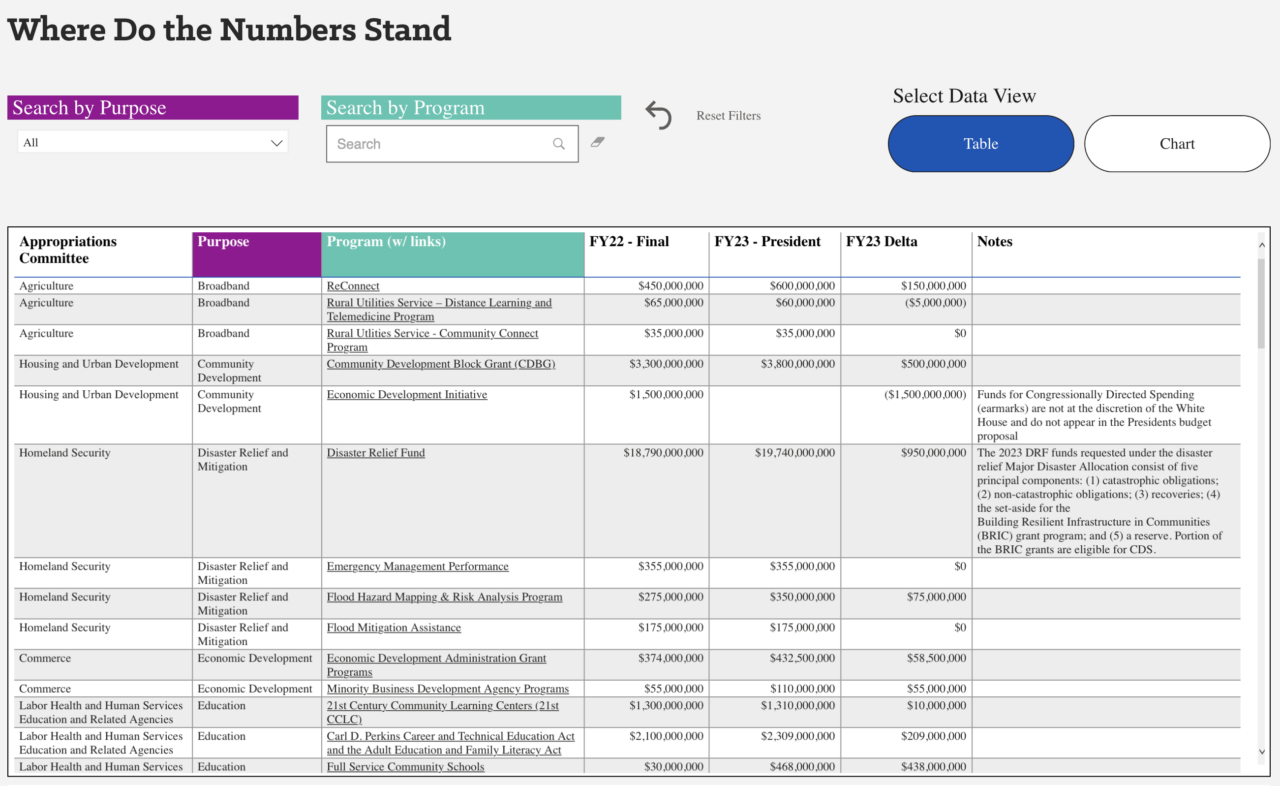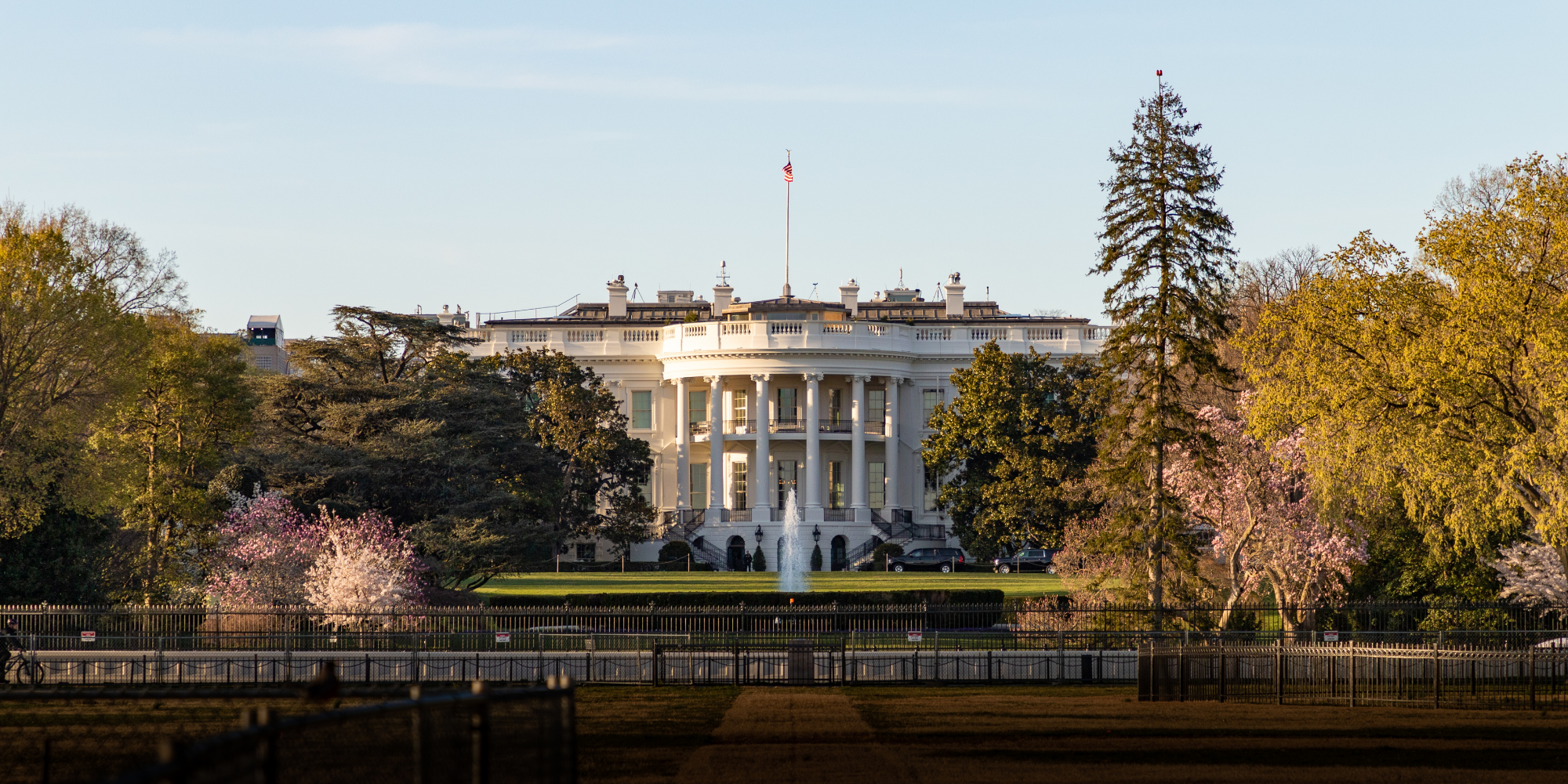On March 28, 2022, President Biden released his proposed budget for Fiscal Year 2023 (FY23). The President’s Budget communicates the Administration’s spending priorities to Congress, which is the first step in the federal budget and appropriations process. This budget is not set in stone but a roadmap for funding the federal government. Now, it is up to Congress to negotiate spending caps for the 12 federal appropriations bills for FY23 and determine final funding levels before the start of FY23 on October 1.

Visit our interactive tracker for a full breakdown of the president’s proposed budget. You can view the proposed funding levels and how they compare to FY22 funding levels. The tracker will be updated as the appropriations process moves forward.
Local leaders in cities, towns and villages may be wondering what parts of the bill they should keep an eye on. Below are local government priorities included in the president’s budget. NLC will continue to advocate for this funding as Congress negotiates.
Supports Public Safety and Law Enforcement
The budget increases funding for gun violence prevention ($884 million), community violence intervention ($250 million), law enforcement officer training on responding to individuals with mental illness or disabilities ($10 million), Project Safe Neighborhoods ($40 million), juvenile justice programs ($760 million), and hiring additional law enforcement officers ($537 million).
Increases Investments in Environmental Cleanup
The budget includes a significant increase for Brownfields funding, with a proposed total of nearly $131 million. This is in addition to the increased funding from the Bipartisan Infrastructure Law. The Brownfields program is one of the most useful programs at the local level that supports the revitalization and redevelopment of vacant and abandoned properties that blight communities across the country.
Strengthens Water Infrastructure
The budget provides level funding for the Clean Water and Drinking Water State Revolving Funds ($1.638 billion and $1.126 billion respectively) and an increase in funding for the WIFIA program ($72 million). The budget proposal also includes funding for water infrastructure grant programs, such as sewer overflows and stormwater management, water infrastructure workforce development, and removing lead from drinking water among others.
Addresses Climate Change and Strengthens Community Resilience
The budget proposal includes funding across every federal agency to advance clean energy and reduce greenhouse gas emissions across sectors, invest in pre-disaster mitigation to strengthen infrastructure and reduce the risk of extreme weather events, and advance environmental justice within the communities most impacted by climate change.
Supports Local Transportation Projects
The budget requests $110.7 million for the new Thriving Communities program for technical assistance and capacity building for local infrastructure projects, $1.5 billion for the popular Rebuilding American Infrastructure with Sustainability and Equity (RAISE) discretionary grants and the new National Infrastructure Project Assistance (Mega) Grant program, along with $400 million for the Charging and Fueling Infrastructure Grants Program to further increase electric vehicle charging access in rural and underserved communities.
Increases Affordable Housing Supply
The budget proposes $50 billion in new funding for housing construction and supply – addressing existing market gaps and helping to stabilize housing prices over the long term. This includes funding, via the Department of Housing and Urban Development, for state and local housing finance agencies and their partners to provide grants, revolving loan funds, and other streamlined financing tools to boost housing supply, with a particular focus on housing types that have traditionally been difficult to finance using existing Federal financing but have the potential to increase supply and density in supply-constrained communities.
The budget also includes grants to incentivize state and local jurisdictions’ to examine and update land use and zoning ordinances to better meet residential needs for affordable housing. It includes modifying Low-Income Housing Tax Credits to spur more investment in unit production, and funding for the Department of the Treasury’s Community Development Financial Institutions Fund to support the financing of new construction and substantial rehabilitation that creates net new units of affordable rental and for-sale housing. It increases CDBG, HOME, and Homeless Assistance Grants.
Increases Investments for Broadband Infrastructure
The budget includes additional funding above and beyond that allocated in the Bipartisan Infrastructure Law for rural broadband infrastructure: an additional $600M over FY22 enacted levels for the U.S. Department of Agriculture’s ReConnect broadband grant and loan program, and an additional $25M over FY22 enacted levels for the Rural Utilities Service’s telecommunications program. These programs help to fund and finance broadband services or expansions in rural areas, often served by small, cooperative, or public internet service providers. The budget also includes increases for the National Telecommunications and Information Administration and Federal Communications Commission, which are tasked with administering the majority of the broadband grant programs in the Bipartisan Infrastructure Law.
Strengthens Cybersecurity
The budget increases funding for cybersecurity policy through the FBI, National Institute for Standards and Technology and National Telecommunications and Information Administration within the Department of Commerce, and the Office of the National Cyber Director. In addition, the budget includes a legislative proposal to support election security (both physical and cyber security) and a boost to the Election Assistance Commission of $10 million over FY22, representing a 50% increase.
Invests in Workforce and Postsecondary Education
The budget reflects the national need for investments in workers to address the broad workforce shortages across the country. With an 11% proposed increase to the Department of Labor, it would increase investments in Registered Apprenticeship opportunities while increasing access for historically underrepresented groups, including people of color and women, and diversifying the industry sectors involved, increasing investments in community college postsecondary workforce programs, create a new National Youth Employment program and invest $20 million for the Civilian Climate Corps. The budget also provides an increase of $20 million for Career and Technical Education (CTE) State grants through the Department of Education.
Protects Elections and the Right to Vote
As our democracy faces threats across the country—and to provide state and local election officials with a predictable funding stream for critical capital investments and increased staffing and services—the Budget proposes $10 billion in new elections assistance funding to be allocated over ten years. The Budget also proposes to fund an expansion of U.S. Postal Service delivery capacity in underserved areas and support for vote-by-mail, including making ballots postage-free and reducing the cost of other election-related mail for jurisdictions and voters.









